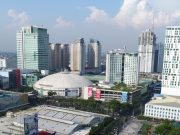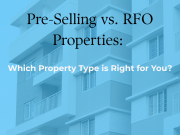The real estate market in the Philippines has been a fertile ground for investors and homebuyers alike. With the country’s robust economy, growing urbanization, and the increasing purchasing power of Filipinos, the demand for residential properties continues to rise. From bustling cities like Metro Manila and Cebu to serene locations such as Palawan and Davao, the real estate landscape in the Philippines offers a variety of options to suit different needs and preferences.
In this dynamic market, two types of property investments stand out: Pre-selling and Ready-for-occupy (RFO) properties. Pre-selling properties refer to units sold by developers before they are fully constructed.
Conversely, RFO properties are fully completed units that are ready for immediate occupation. Both types of investments come with their unique set of advantages and challenges, and understanding them is crucial in making an informed investment decision.
Understanding Pre-Selling Properties
Pre-selling, also known as off-plan property, is a common practice in the real estate industry where a developer begins selling property units before they are finished or even before construction starts. This model allows developers to finance the project partially through the sales made during the pre-selling phase.
Investing in pre-selling properties comes with several benefits. Firstly, the initial cost is usually lower compared to RFO properties, making it more accessible for first-time buyers or investors with limited capital.
Secondly, pre-selling properties have a high potential for returns. Since properties are sold at a lower price during the pre-selling phase, investors can benefit from considerable capital appreciation once the project is completed and the market value increases.
However, investing in pre-selling properties comes with risks. There can be delays in construction, changes in the final output, or, in worst-case scenarios, the project may not push through at all. Investors need to do their due diligence and choose reputable developers with a proven track record of delivering their projects on time.
A prime example of a successful pre-selling property investment in the Philippines is the rise of condominium developments in Bonifacio Global City (BGC). Investors who bought units during the pre-selling phase have seen significant returns on their investments due to the rapid development and increasing property values in BGC.
In conclusion, while pre-selling properties present attractive benefits, they also carry certain risks. It’s crucial for investors to carefully weigh these factors before making a decision.
Understanding Ready-for-Occupancy (RFO) Properties
What does Ready-for-Occupancy mean in real estate?
In the real estate industry, Ready-for-Occupancy or RFO refers to properties that are fully constructed and prepared for immediate move-in. Unlike pre-selling properties, RFO units offer the tangible advantage of being able to see and assess the actual property before purchasing.
Advantages and Disadvantages of investing in RFO properties
1. Immediate rental income
One of the primary benefits of investing in RFO properties is the potential for immediate rental income. Given the high demand for rental units in urban areas in the Philippines, such as Makati City, Quezon City, and Cebu City, investors can start earning returns on their investments right away. This is particularly beneficial for those seeking a steady source of passive income.
2. Lower risk factor
Compared to pre-selling properties, RFO units present a lower risk factor. Since the property is already built, investors can handle construction delays and the possibility of the project not pushing through. Additionally, the ability to inspect the actual unit allows investors to ensure that it meets their expectations and standards.
3. Comparatively higher initial investment
On the downside, RFO properties typically require a higher initial investment compared to pre-selling properties. The higher cost is due to the fact that the property is already complete and ready for occupancy, eliminating the wait time associated with pre-selling units.
Successful RFO property investments in the Philippines
One example of successful RFO property investment in the Philippines is the rise of condominium developments along Roxas Boulevard in Manila. Known for its scenic views of Manila Bay, this area has attracted both local and foreign investors. Those who invested in RFO units in this area have benefitted from steady rental income due to the high demand for accommodations, especially from expatriates and tourists.
Moreover, the recent redevelopment projects in this area, such as the rehabilitation of Manila Bay and the construction of new commercial establishments, have further increased property values. As a result, investors who bought RFO units in this area have seen substantial capital appreciation over the years.
Pre-Selling vs. RFO: Which is a Better Investment?
Comparison of return on investment for both options
| Pre-Selling Properties | RFO Properties | |
| ROI | Higher capital appreciation due to lower initial purchase price. However, returns are realized in the long term upon project completion. | Immediate rental income potential. Lower capital appreciation compared to pre-selling properties but yields steady, short-term returns. |
Factors to consider while choosing between pre-selling and RFO
| Pre-Selling Properties | RFO Properties | |
| Financial Capacity | Requires a smaller initial outlay, making it accessible to first-time investors or those with limited capital. | It requires a larger initial investment but can start generating immediate returns through rental income. |
| Risk Tolerance | Higher risk due to potential construction delays or changes in final output. | Lower risk as the property is already built and ready for occupancy. |
| Investment Goals | Ideal for long-term capital growth. | Suitable for steady, passive income generation. |
Expert advice and recommendations
Experts in the real estate industry often advise maintaining a balanced portfolio that includes both pre-selling and RFO properties. This approach helps diversify risks and optimize returns, offering the best of both worlds.
The preference for RFO units is indicative of a desire for lower risk and immediate usability, while those opting for pre-selling units are likely drawn to the potential for higher capital appreciation.
In conclusion, the decision between investing in pre-selling or RFO properties is multifaceted, hinging on individual financial capacity, risk tolerance, and investment goals. A well-balanced real estate portfolio that includes both types of properties can provide both immediate returns and long-term growth potential.
Tips for Investing in Pre-Selling and RFO Properties in the Philippines
How to Choose the Right Property
When it comes to securing a successful investment, making the right choice in property is of utmost importance. Whether you are considering a pre-selling option or a ready-for-occupancy (RFO) one, taking the time to evaluate your options carefully can pay off in the long run. Here are a few tips to guide you in your decision-making process:
1. Buy from reputable developers
Developers with a solid track record of delivering quality properties on time can significantly mitigate your investment risk. One such reputable firm in the Philippines is HousingInteractive, the largest online real estate brokerage company in the country. They provide comprehensive and personalized brokerage services, assisting buyers in finding the perfect property from respected developers.
2. Conduct thorough financial calculations
Estimating all costs associated with your property, including property taxes, maintenance fees, and potential renovation costs, is critical. This will give you a clear picture of your financial commitments and help avoid any unpleasant surprises down the line.
3. Make necessary inquiries
Never hesitate to ask questions about the property. Inquire about the developer’s track record, the project’s permits, and the estimated completion date. HousingInteractive, with its extensive network and industry knowledge, can be a valuable resource in this regard.
Legal Considerations While Investing in Real Estate
Understanding the legal aspects of real estate investment is essential. Ensure that the property you’re investing in has a clean title, free from any liens or encumbrances. Also, familiarize yourself with the terms of the contract to sell (CTS) or the deed of absolute sale (DOAS).
Role of Real Estate Brokers and Agents
Real estate brokers and agents can provide valuable assistance when investing in pre-selling or RFO properties. They can help you navigate the property market, provide insights into promising locations, and assist in the negotiation process.
Understanding the Real Estate Laws in the Philippines
The Philippines has specific laws governing real estate transactions. For instance, under Maceda Law, buyers can get a refund if they decide to back out of a pre-selling agreement after making at least two years’ worth of payments. It’s crucial to familiarize yourself with such laws to protect your interests.
We’ve explored the differences between pre-selling and RFO properties, their respective advantages and risks, and the factors to consider when choosing between the two. We’ve also provided tips on making wise investments in both types of properties.
Both pre-selling and RFO properties have their unique advantages, and the choice between the two largely depends on your financial capacity, risk tolerance, and investment goals. By doing thorough research and due diligence, you can make informed decisions that align with your real estate investment objectives.

























